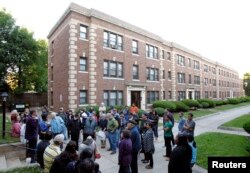During the COVID-19 pandemic, the U.S. states of Florida, Idaho and Montana grew the most in terms of population, while New York, Illinois and Louisiana suffered the most shrinkage from July 2020 through July 2022, according to new data from the U.S. Census Bureau.
The changes occurred as America’s overall population growth dropped to a new low.
“It increased the number of deaths quite dramatically, and it lowered births, as well, and decreased the amount of international migrants that came to the U.S.,” says demographer William Frey, a senior fellow with the Brookings Institution.
A demographer is an expert in statistics about human populations.
“The national population totals, especially from 2020 to 2021, was the lowest growth in over 100 years,” Frey says.
Among the hardest hit were the nation’s 56 cities and metropolitan areas with populations of over 1 million. Frey said that's the first time that has happened since at least 1990 [the first year that data was kept] and probably decades earlier than that.
“All of it was affected by the national patterns of more deaths, fewer births and less immigration, but also domestic migration,” says Frey, who is also a research professor at the University of Michigan's Population Studies Center. “People leaving because maybe their jobs were not necessarily requiring them to be in [an] office. … People not wanting to be in dense places with close interaction with people.”
However, the most recent census numbers, covering the period between July 2021 through July 2022, suggest that big cities are bouncing back now that the pandemic has been downgraded and is no longer considered a global health emergency. For example, New York City experienced about a 6% population decline between 2020-2021, the first full year of the pandemic, but showed a slight gain between 2021-2022.
“We're not going to keep that level of out-migration and population loss for big cities and for big metropolitan areas,” Frey says. “There’s some chance, from these new numbers, that things are going to return a little bit more towards normal.”
When it comes to the top-growing states between 2020 and 2022, Americans continued the trend of relocating to Florida for the climate and lower cost of living. Many of the newcomers to Idaho and Montana were people departing California.
In terms of shrinking the most, it’s the ninth year in a row that Illinois showed significant population losses, while Louisiana is also continuing a downward trend exacerbated by deadly hurricanes. Some have interpreted the numbers to show that people are leaving Democratic-led “blue” states for Republican “red” states.
Typically, when people decide to move, it's usually on the basis of jobs or cost of living and housing, and maybe living close to members of the family,” Frey says. “To move to a place because of the politics, maybe some people do that but … states that have gained population, like Texas and Florida, have gained population for decades no matter what the politics was.”
The most expensive states to rent an apartment in are Massachusetts ($2,632 monthly), New York ($2,552 monthly) and California ($2,506 monthly), according to RentCafe, an apartment listing service.
Jesse Rhodes, a political science professor at the University of Massachusetts Amherst, co-directed a poll that found 39% of Massachusetts residents — almost 4 out of 10 people — have thought about leaving the state in the past year.
The census numbers show that 47,853 people left Massachusetts from July 2020 to July 2021, while 47,318 moved out of state from July 2021 to July 2022.
“The top reason why people who said that they're thinking about leaving the state indicated that they were leaving to escape the high cost of living,” Rhodes says. “Massachusetts is a relatively expensive state. In some ways, it's a victim of its own success. It's attractive, and many people want to live here, particularly relatively affluent individuals. And what that means is that they can bid up the cost of living, and particularly, the cost of housing.”
The poll also found that more than half of the state’s Republicans, 53%, and 60% of conservatives, considered leaving.
“Massachusetts is one of — if not the most — progressive state in the entire country, and Republicans are in many ways locked out of significant political power,” Rhodes says. “So, that leads to significant frustration.”
What concerns Rhodes is the numbers of young people, 43% of 18-29-year-olds, who are thinking about moving, including 41% of those with a college degree and 42% of those with a post-graduate degree.
“States need to have a growing and dynamic population to maintain a strong economy, to maintain a vibrant social and cultural life,” Rhodes says. “We have to maintain a healthy population, but then also, politically, in terms of the state's ability to have influence in national affairs, having a robust population is very important.”
The U.S. population grew 0.38% between July 2021 and July 2022, which was faster than the historic low of 0.16% during the first full year of the pandemic, according to Frey, who adds that most of that increase was due to immigration. And while big cities appear to be rebounding, it could be years before the full impact of the pandemic is felt.
“We're not going to really know for maybe three, four or five years down the road, when we see how workplaces adapt, if people decide they're going to do hybrid work or not do hybrid work, and all of that,” Frey says. “So, cities have to sort of roll with the punches.”











